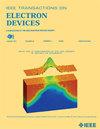Alleviated Asymmetry in Carrier Transport With V-Shaped Multiple Quantum Wells in AlGaN-Based DUV LEDs
IF 2.9
2区 工程技术
Q2 ENGINEERING, ELECTRICAL & ELECTRONIC
引用次数: 0
Abstract
AlGaN-based deep-ultraviolet light-emitting diodes (DUV LEDs) still suffer from relatively low light output power (LOP) and poor external quantum efficiency (EQE) due to the severe electron leakage and hole-blocking effects. Electrons tend to accumulate in the last quantum well (LQW) and escape from the active region because of the weak confinement ability of the quantum barriers (QBs). Besides, the polarization-induced positive charges at the last QB (LQB)/p-type electron blocking layer (p-EBL) interface will attract electrons and consume holes for nonradiative recombination, leading to inadequate carrier concentration in the active region. In this article, we propose DUV LEDs with V-shaped multiple quantum wells (MQWs) to modulate the distribution of carriers in the active region. With the V-shaped MQWs, carriers are inclined to accumulate in the middle quantum well (QW) instead of the last one, and the polarization-induced electric field in the middle QW is also well alleviated, contributing to improved radiative recombination rates. Furthermore, the original positive sheet charges at the LQB/p-EBL interface are converted into negative ones, which is beneficial for suppressing electron overflow and increasing hole injection efficiency. Therefore, the EQE is remarkably improved by 48.1% at an injection current of 150 A/cm2. The V-shaped MQWs provide an effective solution to realize DUV LEDs with high performance.氮化镓DUV led中v形多量子阱载流子输运的非对称性
由于严重的电子泄漏和空穴阻塞效应,gan基深紫外发光二极管(DUV LEDs)仍然存在较低的光输出功率(LOP)和较差的外量子效率(EQE)。由于量子势垒的约束能力较弱,电子倾向于在最后一个量子阱(LQW)中积累,并从有源区逸出。此外,在最后一个QB (LQB)/p型电子阻挡层(p-EBL)界面,极化诱导的正电荷会吸引电子并消耗空穴进行非辐射复合,导致活性区载流子浓度不足。在本文中,我们提出用v形多量子阱(mqw)调制有源区载流子分布的DUV led。在v型量子阱中,载流子倾向于在中间量子阱而不是最后一个量子阱中积累,并且中间量子阱中的极化感应电场也得到了很好的缓解,有助于提高辐射复合率。此外,在LQB/p-EBL界面处,原片上的正电荷转化为负电荷,有利于抑制电子溢出,提高空穴注入效率。因此,当注入电流为150 A/cm2时,EQE显著提高48.1%。v形mqw为实现高性能的DUV led提供了有效的解决方案。
本文章由计算机程序翻译,如有差异,请以英文原文为准。
求助全文
约1分钟内获得全文
求助全文
来源期刊

IEEE Transactions on Electron Devices
工程技术-工程:电子与电气
CiteScore
5.80
自引率
16.10%
发文量
937
审稿时长
3.8 months
期刊介绍:
IEEE Transactions on Electron Devices publishes original and significant contributions relating to the theory, modeling, design, performance and reliability of electron and ion integrated circuit devices and interconnects, involving insulators, metals, organic materials, micro-plasmas, semiconductors, quantum-effect structures, vacuum devices, and emerging materials with applications in bioelectronics, biomedical electronics, computation, communications, displays, microelectromechanics, imaging, micro-actuators, nanoelectronics, optoelectronics, photovoltaics, power ICs and micro-sensors. Tutorial and review papers on these subjects are also published and occasional special issues appear to present a collection of papers which treat particular areas in more depth and breadth.
 求助内容:
求助内容: 应助结果提醒方式:
应助结果提醒方式:


